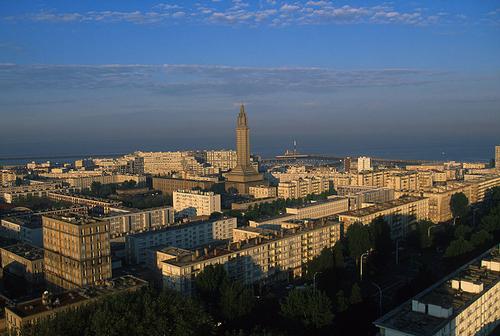FRANCE
Le Havre

Le Havre
Le Havre
Le Havre is a town in the Seine-Maritime department of the Haute-Normandie region in France. Le Havre is located in northwestern France, on the right bank of the River Seine, which flows into the Channel. Le Havre is the most populous municipality in the Haute-Normandie region. According to the 2007 census, the city has 179,751 inhabitants, the metropolitan area has 291,765 inhabitants. The port is the second busiest in France (after the port of Marseille). Since 1974 it has been the seat of the Diocese of Le Havre.
Le Havre was destroyed in World War II, during the invasion of Normandy in 1944. 5,000 people were killed and 12,000 homes destroyed, mainly by Allied air raids.
 Le HavrePhoto: Erik Levilly CC 1.0 Generic no changes made
Le HavrePhoto: Erik Levilly CC 1.0 Generic no changes made
Location
Le Havre is bounded by the coast of the Channel to the west, the mouth of the Seine to the south and the coast to the north. The river Seine used to be the natural border between Haute-Normandie and Basse-Normandie. The city was built from the harbor on the swampy coast. As a result, the city had poor connections with the hinterland. The problem was solved with the construction of new roads and the modern Pont de Normandie connecting the two banks of the River Seine.
The lower town consists of the harbor and the city center. Le Havre is built on old marshes, drained in the 16th century. The rich northwestern part of the upper town is located at an altitude of 90 to 119 meters above sea level.
Weather
Le Havre has a moderate maritime climate. The wind causes influences from the sea all year round. According to the meteorological station, the temperature only drops below 0 °C for 24 days a year and the temperature rises above 25 °C for 14 days a year. The average number of hours of sunshine is 1,878 hours per year. It rains all year round, but especially in autumn and winter. Thunderstorms can occur in the summer months of June and July. The predominant wind blows from the southwest. Storms occur in winter, particularly in January.
 Le Havre Graville AbbeyPhoto: Philippe Alès CC 3.0 Unported no changes made
Le Havre Graville AbbeyPhoto: Philippe Alès CC 3.0 Unported no changes made
Geschiedenis Le Havre
The name Le Havre means the port. Le Havre was established as a new port, in part to replace the historic ports of Harfleur and Honfleur.
 Map Le Havre 1530Photo: Public domain
Map Le Havre 1530Photo: Public domain
The city was founded in 1517 by the French king Francois I and the place was called Franciscopolis. Later the name was changed from Le Havre-de-Grâce to the chapel of Notre-Dame-de-Grâce. The place developed into a city and in the course of the 19th century became an industrial center.
At the end of the Second World War, Le Havre was destroyed in the Battle of Normandy.
Sights
Le Havre BeachPhoto: Urban CC 3.0 Unported no changes made
After the war, the center of Le Havre was rebuilt in a modernist style to a design by the architect Auguste Perret and declared a UNESCO World Heritage Site on July 15, 2005. Le Havre is an exceptional example of the architecture and urban planning of the post-war period.
 Town hall Le HavrePhoto: Philippe Alès CC 3.0 Unported no changes made
Town hall Le HavrePhoto: Philippe Alès CC 3.0 Unported no changes made
Major public buildings designed by Perret himself include the Hotel de Ville (town hall), Bourse du Commerce (stock exchange) and the churches of Saint Michel and Saint Joseph. Le Havre Cathedral is built over the original church from 1536. The cathedral is the seat of the Bishop of Le Havre. During the reconstruction of the city center, 7.7 square kilometers of green spaces were created with parks and gardens and bushes.
 Musee Malraux Le HavrePhoto: Velvet CC 3.0 Unported no changes made
Musee Malraux Le HavrePhoto: Velvet CC 3.0 Unported no changes made
The Malraux Museum houses one of the most important collections of Impressionist paintings in France. There are works by Renoir, Pissaro, Signac, Marquet, Renoir, Sisley, Monet, Guillaumin and Degas, among others.
Tips
 Mont Saint MichelPhoto: Diliff CC 3.0 Unported no changes made
Mont Saint MichelPhoto: Diliff CC 3.0 Unported no changes made
When in Le Havre, go to Mont Sant Michel. This is a peninsula 1 km from the coast. This island used to be accessible only at low tide, but can now always be visited due to the construction of an elevated road. Mont Saint Michel consists of stepped streets and is only accessible to pedestrians.
Speaking of pedestrians, the center of le Havre is also largely car-free and therefore a pedestrian area.
Useful links Le Havre
BBC Country ProfilesWorld Fact Book Explore all Countries
How to call
Last updated December 2025
Copyright: Team - The World of Info